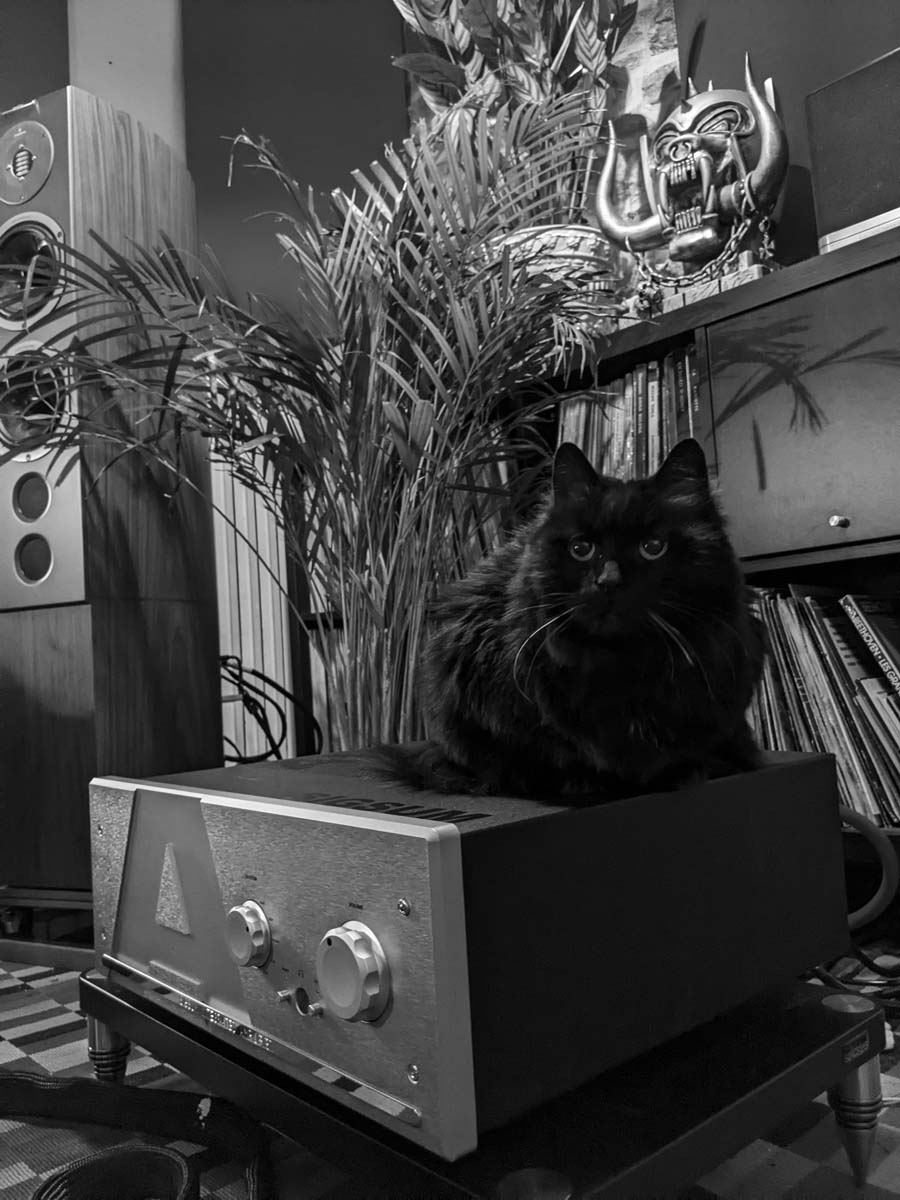AVID SIGSUM REVIEW
Stuart Smith checks out the £15,000 heavyweight integrated amp from UK brand AVID HIFI.

This is a big amp but beautifully made.
Headed up by Conrad Mas, AVID HIFI are proudly based in Huntingdon, Cambridgeshire, England and say that they build “virtually every single component” themselves. Their products, and specifically the amplifier I have in front of me, are built to last a lifetime – and I can believe that. This may seem like a bold claim but the company don’t even have a service department because, they say, their products “rarely come home”. However, there is a five-year warranty included on all their products. This longevity of products is an important one, I believe. We have become far too used to products, in all markets, that are throwaway, or, if not throwaway, products that have a limited lifespan and, dare I say it, with built-in obsolescence. Having a product that has a stated aim to be “Built for life” is definitely somewhat inspiring and I applaud AVID HIFI for this. Fifteen grand is a lot of money for an amplifier, but if AVID’s claim is justifiable with regards to longevity, then it actually makes this amplifier seem, on the face of it, good value for money.
BUILD AND FEATURES
This is an absolute beast of an amplifier and it weighs a ton. Well not quite – it weighs 34.5Kg (76lbs) and is certainly a two-man job to get it onto a shelf. And so I chose to put it on a low-level Solidsteel amplifier stand, but still needed help. Packaging is excellent as you would expect from an amp costing 15,000 quid.
It’s definitely a manly looking amp, but despite this it manages to look pretty elegant. Certainly, I’d say this is one of the nicest looking amplifiers that we’ve had here at HiFi Pig Towers. Now I know looks aren’t supposed to mean anything in the audiophile mindset but they do and Conrad Mas and his team at AVID have done a splendid job of getting the design of the SIGSUM just right – It’s a monster, but it’s a pretty monster.
Essentially what you have here is a 110W per channel integrated amplifier and like all proper integrated amplifiers, it has an onboard phonostage.
Now the phonostage we have aboard the SIGSUM is AVID’s £1799 Moving Magnet and Moving Coil capable PULSUS, along with its own independent power supply. This starts to make the asking price a bit more sensible, even if we take claimed longevity out of the equation. However, the DIP switches (which I dislike at the best of times) are underneath the amp and situated back right. To get at the DIP switches to set the correct loading for your cartridge you have to take the amp off the shelf, carefully tilt it on its side to reveal the switches, set them and then return the amp to its rack. This is a two-man job. As I mentioned, I had the amp on a low-level amp stand and could theoretically have done this myself, but that could have had the amp toppling over and causing damage to itself or something else. This is not likely to be a major inconvenience for the vast majority of users as they are unlikely to change their cartridges very often, but, through necessity, I do change cartridges a lot. Again, I must stress that for the majority of folk this will be a set it and forget it exercise!
Talking of power supplies, there’s a 1.1kVa mains transformer allied with a 132k uF capacitor bank inside the casing to independently power the pre and dual-mono amps. I’m guessing that this is where a good deal of the weight of the SIGSUM comes from.
There is no remote, and whilst I understand that the inclusion of a remote and its associated receiver could potentially impact sound quality, I do think that one would be expected by most folk in this day and age. However, there’s another way to look at this and that’s to suggest that AVID are so focused on the sound quality of the amplifier that they are happy to put the SIGSUM out there without this modern convenience. Indeed, the AVID website’s main page does make mention of the company actively avoiding all things digital. You pay your money and you takes your choice!
On that highly distinctive front panel you have two absolutely gorgeous knobs, one for the ALPS RK50 volume control and one for source selection. Both look and feel great to use! There’s a mono switch, a mute switch and a quarter-inch headphone jack – that’s it. It’s a masterclass in high-end elegance! Clio, one of the HiFi Pig cats clearly loved the amp and laid claim to it immediately and it did become the favoured “spot of contention” between the two felines over the couple of weeks it was down here in the main system – it had been left in the upstairs system to run in prior to this.
Round the back of the amp you have the phono input and ground post and then a further pair of inputs where you can use RCA or balanced XLR inputs, a preamplifier out on RCA and a pair set of good quality speaker binding posts. This may seem limiting, but it actually gives you two balanced and two unbalanced inputs that are switchable from the front panel and so in reality this should be adequate for most people’s needs. Below the speaker-binding posts is the mains inlet, though the only power switch on this amp is centrally placed under the amp’s front panel.

Four inputs (2RCA and 2 XLR) plus an input for your record player.
The feet are the same solid machined shape as the control knobs and whilst I couldn’t see them from my sitting position, it’s an attention to detail I really liked.
As an aside, and feel free to skip this bit as it’s nothing to do with the review, I was a little intrigued by what the word SIGSUM meant and I had assumed it was going to be something Latin meaning powerful, or some other rather manly sense. However, I searched the internet and was left wanting with regards to a Latin word. Greek then? Nope! The only definition I could find was a military term meaning SIGint SUMmary. So what did SIGINT mean? This is what I found on the National Security Agency website: “SIGINT is intelligence derived from electronic signals and systems used by foreign targets, such as communications systems, radars, and weapons systems that provides a vital window for our nation into foreign adversaries’ capabilities, actions, and intentions.” All that sounded plausible and rather butch, but I thought it best to contact AVID HIFI direct. Actually, the truth was much less dramatic and the name is just the SUM of two SIGnals.
SOUND QUALITY
When I reviewed the Aavik integrated recently I made the comment that it’s often pretty easy to click if a new bit of kit in the system is any good very quickly and the AVID SIGSUM is one of those kinds of products too. Immediately it sounded effortless and in command as I played whatever was left on the turntable overnight – don’t worry, we have a lid. I was going to enjoy my time with this amp, that was for sure!
I decided from the off that I wanted to test this amp out primarily with the Audiovector R6 Arreté given the amp and speakers’ price (speakers are around €26K) and I was utterly delighted I did. Thing is, reviewing has to be fun at times and this partnership brought the fun-factor by the bucketload. When I say fun I’m not talking some dirty techno club in the seedier area of Berlin fun, I’m talking a swanky Parisian after-hours club with fancily-clad folk and waiters with trays of champagne doing the rounds. After a few tunes I’d got this vibe into my head and picked out the fantastically chilled Aqua Bassino on F Communications – it’s from ’97 but still sounds fresh as a newly popped bottle of Perrier Jouet Belle Epoque. The amp and speakers work in perfect harmony here with the deep bass being perfectly controlled and room-filling on Na Na Waltz. Nothing overdone mind, just absolutely there and in the room. The soft cymbal reaches out into the room but still sits in its correct position in the mix and never moves from it. The strings sit well back in the mix as they should and the chilled piano is, like the bass, in the room lifelike. I thought this amp was going to be a class act and I was bang on the money! Of course, there’s nothing taxing about this particular track, but get it wrong and the bass, in particular, can get to sound messy and a bit all over the place. The SIGSUM isn’t that at all, in fact, it’s the exact opposite and I’d say that on the strength of this one track alone that the amp has more control than our resident Krell (KST 100 but full overhauled and brought to “as-new” by Krell in the States). That’s a pretty big statement for me to make as I do love what our Krell adds to the system. To me, the AVID amp sounds more organic and a tad more natural. Both sides play and I change the cartridge from a Sumiko MM to our Gold Note Tuscany Red. So far I’ve been playing vinyl through our LAB 12 melto into the line-level input of the amp via balanced XLR as I wanted to be able to switch to the onboard phono of the SIGSUM and do on-the-fly (ish) comparisons. Here the trumpet of Collin Steele on Welcome Home sounds as lifelike as I’ve heard it and, again, the amp allows me to reach out and touch the mix. Small details in his playing aren’t lost in any part of the audio chain and the whole tune just sounds so dynamic and right. There’s a fair bit going on in this late-night-vibe-jazzy-techno (new genre for you right there) track but the amp just takes in its stride and does its job of getting the best from the speakers. Where the superb Aavik I had recently in this system sounded very accurate and HiFi, I’d suggest that the AVID amp brought a little more of a warm feeling to the system. I’ve read reviews where “warm” is used by the person reviewing the kit to mean that the treble is rolled off, but that’s not it here by any stretch of the imagination.
I plugged the CD player into the same input (RCA rather than the XLR) whilst leaving the XLR in place to make sure I was right with regards to being able to have 2 RCA and 2XLR inputs at the same time…I was right and so you do get 4 inputs plus the phono. Result!
Roy Harper’s Bullingamingvase was in the tray and so that’s what I played. There’s a long and rambling spoken-word intro to the tune Whiteman and the SIGSUM sounds very, very quiet and adds no background noise that I can hear. The little noises the audience makes are clear and the striking match is easy to hear. You can also hear the North-Western English twang in Harper’s voice very clearly. Again, once the tune gets going the sound is full-bodied and rounded -crap choice of words but they say what I want to convey. To use another wine analogy, if the Aavik was a glass of Sauvignon Blanc the AVID is a large glass of Bordeaux. The AVID is more accessible I’d say, but the Aavik a little more steely accurate – you takes your choice and, like the wines, both excellent but different.
To satisfy our needs an amp needs to be massively dynamic and has to be able to react to changes in volume or small changes in playing style instantaneously. The AVID does this effortlessly and without breaking a sweat. Never once did it feel like it was in anything but total control of the speakers from the lowest bass notes to the very top. However, I did plug in a CD player without going through our usual DAC at one point and I would say that the AVID spares no prisoners. You will need good sources to feed this amplifier to get the best out of it and our LAB 12 dac was a very good match at just shy of 3 grand, but I’d not hesitate to partner the SIGSUM with much higher-end (read expensive) kit.

A view from the top of the SIGSUM
PHONOSTAGE
In the position it was in (on a low stand) getting the amp on its side and setting the DIP switches for the correct cartridge loading wasn’t too much of a hassle at all, but still required two of us to make sure the amp didn’t fall over.
However, it’s worth the effort and there’s no doubt that this is a quality phonostage. It’s very, very quiet and hugely detailed, allowing the cartridge to add its own flavour to the dish; this I like…a lot. You can spend a lot of money on cartridges only for the phonostage to stamp its own colour on the sound, but the stage inside the SIGSUM is as neutral as you could wish for. Allied to the amp’s electronics you have a hugely detailed and yet unfatiguing sound that is wide and stable in its presentation, and both dynamic and unforced.
For the vast majority of people this is the only phonostage you will ever need and I really don’t envisage anyone buying the SIGSUM ever feeling any desire to want to replace it with an external product. And in a way that’s what the SIGSUM represents – an amplifier you buy once without getting all worried that you could upgrade this or feel the need to improve that. It’s a product you buy once and keep.
HEADPHONES
I don’t currently do a whole lot of headphone listening but wanted to try the onboard amp on the AVID out for the sake of completeness. Plugging headphones in kills the sound through the speakers and using the Sendy Peacock cans I had no complaints. There’s again a very detailed performance that I would argue errs on the side of being less hyper-analytical and more full-bodied. Once more, there’s no doubt in my mind that the onboard amp will more than suffice for the vast majority of people and I’d be very surprised if any owner of this amp went out and bought a separate headphone amplifier.
QUIBBLES
DIP switches for the phonostage are underneath the amp and there’s no remote. That’s it!
CONCLUSION
I think there is a very sensible (sensible as in sensible consumers) market for the SIGSUM from AVID HIFI and that is those folk who aren’t all caught up in that audiophile merry-go-round of swapping kit every five minutes. Go hear it, buy it, enjoy it!
Basically, it does everything you could want and has ample inputs for most people.
Sonically it is a classy performer and brings power, control and dynamics. At the same time, it also brings subtleness and a feeling that it’s never really trying too hard to deliver.
The onboard phonostage is excellent, with my only caveat being that to change the DIP switches you need to get underneath the amplifier.
Some will bemoan the lack of a remote control and I do get this. However, I’m sure the decision not to have one is based on delivering the best sonic experience rather than adding a smidgen of convenience. Anyway, I’m sure a lot of us could do with the little bit of exercise not having one will bring, though if you are streaming from your armchair using Roon, for example, and a particularly loud track comes into the mix then you either have to jump up or use Roon’s volume control until you get there.
Would I have one? At the moment I wouldn’t because my needs necessitate a different feature set, but in the future and should those change then I reckon this amp would be right up there on my VERY shortlist (in black rather than silver); It’s one box, looks fantastic and sounds really rather wonderful, though I’d not want to be moving it all that often. I would at this time, however, seriously look at the CELSUS stereo amp or the REFERENCE STEREO if they bring the same sonic wonder to the party.
Some may argue that a modern-day integrated should have an onboard DAC and streaming module, but I’d argue that this technology moves so quickly that to have included one would have built obsolescence into the amp.
I’ve deliberated long and hard about this amp and the award I’m going to give it. There is no doubt that at this price it is up there with the best – the very best. There is also no doubt that its onboard feature set is comprehensive enough for most people. However, I have to take into consideration the positioning of the DIP switches most of all and that is down to a convenience thing rather than anything else and with my particular needs in mind. And so I need to put my own needs aside and look at this amp as a regular customer would and for that reason I’m giving it our top award.
I’d still love a remote, though!
AT A GLANCE
Build Quality and Features:
Anyone that made a negative comment about the build of this amp is frankly talking crap! It’s superb!
There’s no remote
DIP switches are underneath
Plenty of inputs for most folk’s needs
Mono switch and a mute switch
Enough power and current for pretty much any speakers
Sound Quality:
Detailed and full sounding
Dynamic and punchy with control and finesse
Fantastic onboard phonostage
Very capable headphone amp
Value For Money:
It’s a proper integrated amplifier in the old tradition with a phonostage onboard
Fifteen grand is a lot of money, but that price needs to be looked at in context and with regards to what the competition costs and the features this amp brings
We Loved:
Fantastic build and looks
Wonderfully detailed and yet rounded sound with massive control and dynamics
That phonostage is great!
We Didn’t Love So much:
No remote
DIP switches underneath
It’s not forgiving of poor kit before it
Price: £15 000
Elevator Pitch Review: This English-made amplifier from AVID HIFI costs £15000 but is built accordingly. Sonically it manages to pull off the wonderful trick of being hugely detailed and dynamic but without being clinical or overbearing. Pair it with a suitable pair of speakers (the Audiovector R6 we used were a fantastic match) and you will have a well-featured amp (it has an excellent onboard phonostage for MM and MC cartridges and a headphone amp) that should last as long as you will. Very highly recommended!
Review Equipment: Technics 1200G turntable, LAB12 melto phono, LAB 12 DAC, Leema Libra, Leema Elements CD. Cables by Tellurium Q, WAY, Atlas. Audiovector R6 Arrete speakers.

Stuart Smith

SPECIFICATIONS
OUTPUT: 110W 8Ω
HARMONIC DISTORTION: 0.003% (80% POWER 8 OHMS 1KHz)
LOUDSPEAKER IMPEDANCE: 4-16Ω
PHONO INPUTS: 2x RCA
GAIN: 48dB – 60dB – 70dB
INPUT RESISTANCE: 100R – 300R – 500R – 1K – 5K – 10K – 47K
INPUT CAPACITANCE: 100pF – 200pF – 500pF
LINE INPUTS: 4x XLR 4x RCA (2 x Stereo of each)
OUTPUTS: 4x GOLD PLATED HIGH CURRENT
LINE LEVEL OUTPUT: 2x RCA (1x Stereo pair)
HEADPHONE OUTPUT: 10 V RMS
HEADPHONE RANGE: 20 — 600Ω
INPUT VOLTAGE: 115V OR 230V AC
DIMENSIONS: 471 x 500 x 190mm (WXDXH)
NET WEIGHT: 31.2KG (69LB)








































































































































































































